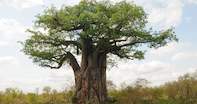
African trees guide to tree species in the Kruger National Park and South Africa. This Africa Tree Guide includes descriptive information, images and the latin names of trees, as well as where they can be found.
Baobab

Adansonia digitata, or Baobab tree, was named in honour of Michel Adanson, the naturalist who first saw it in Senegal, Africa about 1750. The Baobab tree is a strange looking tree that grows in low-lying areas in Africa.
Buffalothorn

The Buffalothorn is a deciduous tree, which grows up to 17m tall. It is a fast growing, deciduous, drought and frost resistant tree. The bark is rough and is dark grey to brown in colour. The flowers are silver
Bushwillow

A widespread, fairly common shrub, the Bushwillow grows up to 4m tall, and grows on both deep sand and loamy sand. The leaves are relatively large compared to other Combretum species. The flowers appear in greenish.
Jackalberry

The Jackalberry tree can grow very tall, up to 80 feet, with a trunk circumference of 16 feet. Most trees don't grow that tall, however, and heights of 15 to 18 feet are more usual. The trunks grow straight and high, with the first.
Knob Thorn

The Knob Thorn grows 5-18 m in height and is fire-resistant. The common names in English and Afrikaans refer to the very characteristic thorns, which are knobbed. The knobs, which are borne on the trunks and branches, are occasionally lacking.
Lala Palm

Locally called Molala, large Lala Palm trees usually 5 to 7m, but sometimes up to 15m in height, single or multi-stemmed, with a slight swelling about half way up the stem. Fruit take about two years to reach maturity.
Marula

The history of the Marula tree goes back thousands of years. Archaeological evidence shows the marula tree was a source of nutrition as long as ago as 10, 000 years B.C. Marula, Scelerocarya birrea.
Mopane

The most diagnostic feature of the Mopane tree is undoubtedly the butterfly-shaped leaves, which are bright green when they emerge but turn into a kaleidoscope of autumn colours later in the season.
Nara Plant

Acanthosicyos horrida, or the Nara Plant, forms clumps of vegetation in the dunes of the Sossuvlei region near Walvis Bay. Acanthosicyos horrida is a dioecious perennial cucurbit attaining a height of about 1.5 m.
Natal Mahogany

The Natal Mahogany tree (Trichilia emetica) grows in open woodland and riverine bush from Sudan to Kwazulu-Natal. The leaves are glossy green and the flowers smell sweet.
Sausage Tree

The Sausage tree of sub-Saharan Africa is beautiful in flower. The blood-red to maroon flowers hang in long panicles. The fragrance of the flower is not pleasing to humans but attracts.
Tamboti

Deciduous and of medium height, the Tamboti tree bark is characteristically rough and black. The milky latex can cause severe irritation to the skin and eyes. Furthermore, it is not used as a cooking fuel.
Umbrella Thorn

The bark of an Umbrella Thorn tree has a rough feel and is grey to black in colour. The tree has a combination of one straight thorn with a small hooked thorn alongside. The thorns are thin and grow in pairs. The flowers form in clusters
Weeping Boer Bean

The beauty of the Weeping Boer Bean flowers is in the brightly coloured calyces (sepals), stamens and pedicels (flower stalks). The flowers produce copious amounts of nectar, which over-flows and drips or 'weeps'
Wild Date Palm

The Wild Date Palm has feather-shaped leaves. This evergreen palm does not grow much more than 6m in height and often occurs in dense stands, with one or more curving stems rising above the rest.
Welwitschia

Welwitschia Mirabilis plants are unusual for their large, strap like leaves that grow continuously along the ground. The Welwitschia is endemic to the Namib Desert.

